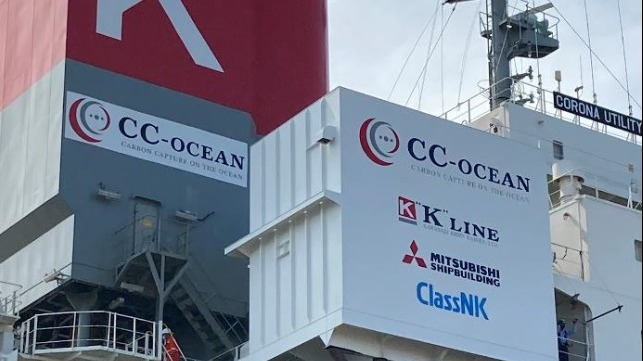"K" Line Successfully Captures CO2 in Shipboard Trial

Pilot projects exploring the possibility of utilizing carbon capture technology aboard ships are making strong progress toward providing a vital tool for decarbonization. While some industry experts have questioned the practicality of using CO2 capture aboard ships, the first tests are reporting successes with the potential of the technology to be commercially available in as few as two or three years.
The first test for the use of carbon capture on an operating ship reports that they have been successful in separating and capturing CO2 from the exhaust gas emitted in service from a coal carrier operated by Japan’s Kawasaki Kisen Kaisha ("K" Line) for Tohoku Electric Power Company. In August 2021, the partnership working with Mitsubishi Shipbuilding installed a small-scale CO2 capture plant aboard a five-year-old 88,715 dwt bulk carrier the Corona Utility.
Initially, experts from Mitsubishi Shipbuilding were onboard the vessel to operate, maintain the plant, and instruct the ship’s crew how to operate it. They also measured, analyzed the captured CO2, and evaluated the system performance. Starting in mid-September, the ship’s crew has been conducting the operation, measurement, and maintaining the plant. They will continue to evaluate the safety and operability of the CO2 capture plant to determine future issues to be considered and conduct research and development for the potential commercialization of the technology.
"K" Line and Mitsubishi reported that the system is performing in line with expectations. Their measurements showed the captured CO2 had a purity of more than 99.9 percent. They believe the captured CO2 can be repurposed for a wide range of applications, including chemical processes to enhance the production of fertilizer or methanol, general use such as dry ice for cooling, and enhanced oil recovery to increase crude oil production.
The companies believe that the results enhance the potential for practical applications of marine-based systems. They plan to proceed with their research and development efforts.
Wärtsilä and Solvang
In a separate development for carbon capture technology, Wärtsilä Exhaust Treatment and Solvang ASA, a Norwegian shipping company, have also agreed on a full-scale pilot retrofit installation of a carbon capture and storage system on one of Solvang’s ethylene carriers. Wärtsilä will design the retrofitted unit while it also completes a land-based 1MW test system. The land-based unit will be completed in autumn 2021, and the companies expect to retrofit the pilot system on the 21,000-cbm Clipper Eos by 2023.
“Carbon capture and storage is an exciting development that we are proud to support, and strongly believe that this technology could be an important key to decarbonize the world’s deep-sea fleet,” said Edvin Endresen, CEO at Solvang ASA.
The Clipper Eos is a two-year-old vessel operating under a time chartered by Marubeni Corp. of Japan. Marubeni will be cooperating with Solvang and Wärtsilä to enable the relevant testing and installation of equipment on the vessel.
“Joining forces with Solvang to build and retrofit a commercially viable CCS technology demonstrates to the industry that we are only two or three years away from bringing to market another vital tool in shipping’s decarbonization toolkit,” said Sigurd Jenssen, Director at Wärtsilä Exhaust Treatment. “Our land-based test unit is nearing completion, and we will then move to make it a reality on the Clipper Eos.”
In addition to the project with Solvang and scaling its Moss CCS test unit, Wärtsilä recently announced it is partnering with the LINCCS consortium to scale and create carbon capture technologies and infrastructure. The consortium recently received more than $13 million in funding for CCS research and development.
